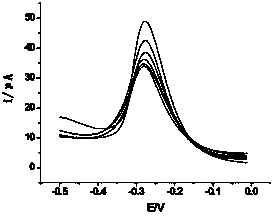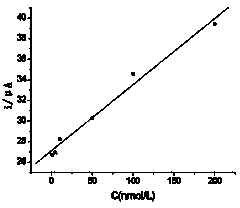Method for detecting pesticide residue amount of chlorpyrifos in vegetables
A chlorpyrifos pesticide and residue technology, applied in the direction of electrochemical variables of materials, can solve the problems of low sensitivity, low accuracy, easy to be affected by interfering substances, and many experimental interference factors, and achieve good selectivity, strong influence ability, low cost effect
- Summary
- Abstract
- Description
- Claims
- Application Information
AI Technical Summary
Problems solved by technology
Method used
Image
Examples
Embodiment Construction
[0034] Below in conjunction with embodiment the present invention is further described, but the present invention is not limited to embodiment.
[0035] The invention provides a method for detecting chlorpyrifos pesticide residues in vegetables, which is specifically realized by using a nano-graphene electrochemical sensor.
[0036] In specific applications, chlorpyrifos will undergo electrochemical behavior on the graphene electrochemical sensor, which is measured by differential pulse voltammetry. The results of graphene-modified electrodes at different concentrations of chlorpyrifos are as follows: figure 1 As shown, the standard curve between the DPV peak current of chlorpyrifos and its concentration is as follows figure 2 shown, at 1.0×10 -9 ~2.0×10 -7 There is a linear relationship within the mol / L concentration range, and the linear regression equation is: ip(μA)= 27.108 +0.06429C (nmol / L). According to the measured DPV peak current of chlorpyrifos in vegetables, the...
PUM
| Property | Measurement | Unit |
|---|---|---|
| diameter | aaaaa | aaaaa |
Abstract
Description
Claims
Application Information
 Login to View More
Login to View More - R&D
- Intellectual Property
- Life Sciences
- Materials
- Tech Scout
- Unparalleled Data Quality
- Higher Quality Content
- 60% Fewer Hallucinations
Browse by: Latest US Patents, China's latest patents, Technical Efficacy Thesaurus, Application Domain, Technology Topic, Popular Technical Reports.
© 2025 PatSnap. All rights reserved.Legal|Privacy policy|Modern Slavery Act Transparency Statement|Sitemap|About US| Contact US: help@patsnap.com


